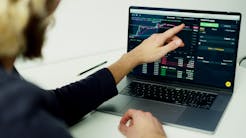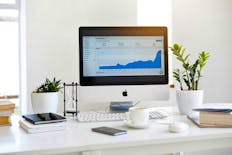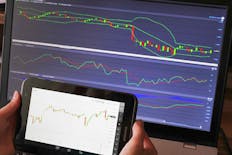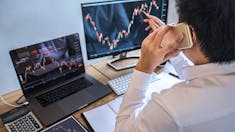Signs You Are Ready to Live Trade
All products and services featured are independently selected by WikiJob. When you register or purchase through links on this page, we may earn a commission.
76% of retail investor accounts lose money when trading CFDs with eToro. You should consider whether you understand how CFDs work, and whether you can afford to take the high risk of losing your money. Don’t invest unless you’re prepared to lose all the money you invest. This is a high-risk investment and you should not expect to be protected if something goes wrong. Take two mins to learn more.
- What Is Demo Trading?
- How Long Should You Demo Trade?
- 13 Signs You Are Ready to Live Trade
empty
empty
empty
empty
empty
empty
empty
empty
empty
empty
empty
empty
empty
- Things to Consider Before Moving to Live Trading
- Frequently Asked Questions
- Final Thoughts
What Is Demo Trading?
Demo trading emerged when online trading gained popularity. The internet, mobile apps, online banking and heightened online security ensured trading platforms could deliver their services to the masses.
Trading and investing is now an option for everyone, regardless of location or upbringing.
So long as you have an internet connection and a device that connects to the internet, you can:
- Take an online trading course for a small fee
- Sign up to a trading platform
- Make money trading and investing
Traditionally, trading and investing were reserved for those in big cities who studied at university learning their craft.
However, you can now do it from your own home.
Despite the ease of access, however, trading and investing can be complicated, and it requires practice.
To give potential users a taste of the trading world, various platforms now offer demo accounts when they sign up.
When you activate your demo account, you are supplied an amount of faux money to begin trading with. All the trades you make are fake; however, the analysis and data are conducted in real-time.
As trading involves money and highly volatile markets, it is highly recommended that you take advantage of a demo account for as long as you need to.
In universities, students are told to run their demo accounts for the duration of their degree.
Already experienced traders use demo accounts when they are considering different assets.
For example, a trader who presently trades exclusively in cryptocurrencies might use a demo account to familiarise themselves with commodities.
They could spend a month or two learning about the different markets and analysing the data before starting trades.
While you may be eager to begin training, spending time on a demo account will:
- Prepare you for the real trading world
- Help you practice your skills
- Enable you to decide what type of trading you like and what strategies you feel comfortable with
- Mentally prepare you for the emotional rollercoaster that is trading
- Allow you to understand the charts and data
How Long Should You Demo Trade?
This depends on the individual.
Some traders will recommend one to three months. Others will say the minimum of a year.
For those with existing trading experience, approximately one or two months are usually adequate as they already understand trading platforms and have experience trading.
For those new to the industry, take as much time as you need.
Trading on live markets with your own money is a consequential activity. Do not feel rushed into something you do not feel ready for.
All traders, old and new, have different levels of comprehension. Some can fully immerse themselves in the markets and trading world; others might juggle a full-time job and learn to trade in their spare time to supplement their income.
Transitioning from a demo account to a live account can be daunting. Taking gradual steps into live trades can help reduce anxiety.
This checklist will help you to decide if you are ready to start trading live:
13 Signs You Are Ready to Live Trade
1. You Feel Comfortable with Your Trading Platform
Before committing to a live account and start trading with your own money, you need to be comfortable with all aspects of your trading platform.
You should be familiar with the analysis tools and enjoy looking at the platform. While aesthetics will not generate a profit, looking at a screen that appeals to you will improve the experience.
Many of the trading platforms do offer customisable interfaces. Ideally, you want to create a screen that is welcoming. You do not want to turn on your computer and see an overwhelming jumble of charts, graphs and figures.
It is advised that your demo account should be with the same broker you intend to live trade with.
Therefore, you should know all the details and have already overcome any problems or issues.
For example, are you aware of slippage, the difference between an anticipated fill price and the final fill price, and your broker’s pip spreads?
If you doubt your trading platform or do not fully understand certain parts, take more time to develop your comprehension before moving to live trades. You do not want to make any avoidable mistakes.
2. You are Excited to Live Trade
Demo accounts are fun and useful to a point. If you believe that you have taken all you can from demo trading and the idea of getting started/the thrill of ‘the game’ gets you excited, then it could be time to begin live trading.
3. You Have Practiced Your Trading Strategy
Going live means real money and real trades. Before making the transition, you need to resist the urge to play with your strategy.
The demo account is your space to make adjustments and find a strategy that works. Only when you have a strategy you feel comfortable with, and an understanding of the analysis tools and indicators should you move to live trades.
As you become more comfortable with live trades, your strategy will change and adapt. However, that is a natural progression that should not be forced.
4. You Are Using Risk Management Strategies
It is a common belief that trading success is the result of good setups and an effective risk management strategy.
In the trading world, events happen that make the markets unpredictable. For a beginner, these events could make you doubt your skills and strategy.
In these cases, your risk management plan may be the one thing that protects your trades.
Before moving to live trades, ensure you have your non-negotiable list of rules to reduce risk.
It should include:
- A limit on the time you spend trading
- The maximum you are prepared to lose on a daily basis
- When to stop trading after a period of losses
- Maximum drawdown
- Understanding of stop loss
You should also be using the risk management tools your platform has available.

5. You Are Consistently Gaining Profit
If you have lost a few trades on your demo account, that is ok. It most likely has nothing to do with your ability, but rather the ever-changing market.
Trading is not a get-rich-quick scheme, and profit should be part of your long-term strategy.
Rather than focusing on big wins, use your skills to find high-probability setups or trades with desirable reward and risk ratios.
You should be checking your profit every month to see if your strategies are working, and make alterations as necessary.
Assessing your wins at the end of every trading day is not a healthy or sustainable strategy.
6. You Have Money to Invest and a Savings Account
Anyone serious about trading requires a decent amount of funds to get them started.
However, startup costs vary depending on the type of trading or investing you intend on doing. Investing in stocks requires you to have the money upfront, while spread betting needs less to begin.
Most trading platforms do not require a minimum deposit; however, it is advisable to have a fair amount saved.
Using your demo account should make you aware of the costs involved with a trade, making it easier to plan and budget.
As part of your risk management strategy, you should also have a dependable savings account to support you.
The savings account is not a backup trading fund but a safety net should you need help paying the bills.
7. You Have Set Realistic Trading Goals
Before you move to a live account, it is important to set realistic goals and expectations.
Trading and investing always have the potential to go wrong, and there are no guarantees.
While your goals should reflect your desire to make a lot of money, they should also have an element of reality.
Before moving to live trading, clearly define your long-term goals and the short-term goals that will get you there.
Do not try to push yourself too hard or set overly ambitious targets. They will only result in burnout or avoidable mistakes.
8. You Know What Type of Trader You Want to Be
There are four main types of trading strategy:
-
Day traders who buy and sell stocks and shares in one trading day. This is a short-term strategy, and the securities can be purchased and sold many times in the space of a few hours.
-
Scalping is another short-term strategy. The trader makes many trades and profits off of small price changes.
-
Swing trading involves keeping hold of the security for a short time (anything from a few days to a few months) before selling the stock, making money from predicting the price move.
-
Position trading whereby you keep the security for an extended period of time (usually three years or more) before selling it at a profit.
Before moving to a live account, you need to be clear on the types of traders and which you intend to be.
A demo account allows you to try all options, making it easy for you to decide with ones suit your strategy.
9. You are Managing Your Emotional Reactions
Live trading requires much more emotional control than a demo account. You’re using real money; figures are changing every second.
It is a sensory overload, and it is very tempting to react, especially when you are just starting out.
Learning how to govern your emotions to make informed decisions is part of the learning process. However, no matter how many times you try to recreate the emotional detachment you have in a demo account, you will always have that voice that says, ‘this is real money'.
If you can make smart decisions in your demo account without your emotions getting in the way, you could be ready for a real account.
However, when making the move:
- Give yourself time to acclimatize to the new level of intensity and a genuine feeling of loss
- Start with low risk and small trades
- Remember your strategy
10. Losses Don’t Impact your Trading Decisions
Losses in trading and investing are inevitable. How you respond to them is what matters.
It is essential to remain calm, even if you feel like everything is going wrong. Making decisions based on a loss leads to impulse decisions that have nothing to do with your strategy.
The more experience you have dealing with a loss will help when you go live.
However, be prepared that a loss in a demo account is nothing compared to real life. Before making your move, you need to be 100% certain that you can keep a level head and follow through with your strategy.
11. You Recognise the Need for Patience
Building a diverse and profitable trading and investing portfolio takes time and dedication. As does learning and perfecting your craft.
Understanding the need for patience is a sign that you are ready to trade live.
Before making the move, you are confident that you have dedicated enough time:
- To learn how to use all the tools on your platform
- To watch and understand the markets
- To experience success and losses in your demo account
- To understand signals and indicators
- To develop your trading strategy
12. You Are Not in It for Quick Wins
Just as you understand that trading is about patience, you also understand that there are very rarely quick wins.
Legitimate trading and investing does not result in overnight success stories or immediately full bank accounts.
A trader ready for a live account has a long-term financial plan and understands the time needed before seeing any real success or income.
13. You Are Committed to Learning and Development
Trading requires constant study. It does not stop once you close your demo account.
As a trader, you need to:
- Keep up to date with any technological updates that change the way you receive and read data
- Constantly watch the markets, keeping an eye out for events that could impact companies or indices
- Actively seek to understand analysis better so you can stay ahead of trends or identify them earlier
- Look for opportunities in new, up-and-coming markets and industries
Things to Consider Before Moving to Live Trading
After evaluating the above checklist, you should also consider the following before making your final decision:
-
How much time can you dedicate to trading? Will it be your full-time occupation or is it an income supplement? Trading only takes place between specific hours. You need to be certain that you are available during those hours.
-
The level of risk. Your demo account has given you some exposure to the risk; however, it is incomparable to the real thing. Before making any financial commitments, fully assess all the risks involved.
-
Double-check for any hidden-fees. You do not want to have to pay more than you thought, especially if the trade does not go your way.
Frequently Asked Questions
You should know the basics of trading and have a trading plan before you start live trading.
You should also have practiced using a demo account and gained some experience trading in a simulated environment.
Additionally, you should have a risk management plan in place and be comfortable with the potential risks involved in trading live accounts.
The best brokers for beginner traders are those that offer educational resources, a user-friendly platform, low fees and access to a demo account.
Some popular brokers for beginners include eToro, TD Ameritrade and Fidelity.
Most trading platforms offer demo accounts for traders to practice and test their strategies without risking real money. Some popular platforms with demo accounts include MetaTrader 4, Thinkorswim and TradingView.
Before starting to live trade, you should have a trading plan, risk management plan and be aware of the potential risks involved in trading.
You should also have some experience trading using a demo account and have a clear understanding of the fees associated with trading.
The risks involved in live trading include potential losses of invested capital, unexpected market movements and psychological factors, such as fear and greed.
It's important to have a risk management plan in place to mitigate these risks.
Some common mistakes made by new traders include not having a trading plan, overtrading, using too much leverage and not following a risk management plan.
It's important to educate yourself and practice good trading habits to avoid these mistakes.
The amount of money needed to start live trading varies depending on the broker and the type of account.
Some brokers allow traders to start with as little as $50, while others require a minimum of $1,000 or more.
The type of trading strategy to use depends on your individual goals and risk tolerance.
Some popular strategies include trend trading, swing trading and day trading.
It's important to research and practice different strategies to find what works best for you.
Whether to trade part-time or full-time depends on your individual circumstances and goals.
Many traders start part-time while they are still learning and gradually transition to full-time trading as they gain experience and confidence.
If you experience a losing streak, it's important to take a step back and evaluate your trading strategy and risk management plan.
It may be helpful to take a break from trading to reevaluate and adjust your approach.
To start live trading, you will need a trading account with a broker, a trading platform, and access to market news and analysis.
You may also want to use technical analysis tools, such as charts and indicators, to help inform your trading decisions.
You can stay up-to-date with market news and events by following financial news outlets, subscribing to newsletters and utilizing tools such as economic calendars.
Social media can also be a useful tool for staying informed about market developments.
Final Thoughts
Making the move from a demo account to a live account is both scary and exciting. But only you know when you are ready.
Don’t:
- Feel pressured to make the move if you are not ready
- Make the move for the wrong reasons
- Forget that your strategy is the key to your success
Do:
- Make as many mistakes and try as many strategies as you like with your demo account
- Spend time learning about the industry
- Keep learning
If you have any doubts, keep your demo account for a little longer until you have 100% certainty.
WikiJob does not provide tax, investment or financial services and advice. The information is being presented without consideration of the investment objectives, risk tolerance or financial circumstances of any specific investor and might not be suitable for all investors. Past performance is not indicative of future results. Investing involves risk including the possible loss of principal.
76% of retail investor accounts lose money when trading CFDs with eToro. You should consider whether you understand how CFDs work, and whether you can afford to take the high risk of losing your money. Don’t invest unless you’re prepared to lose all the money you invest. This is a high-risk investment and you should not expect to be protected if something goes wrong. Take two mins to learn more.










